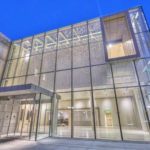
Editor’s note: Asheville author, historian and poet Laura Hope-Gill wrote the following in a Facebook thread debating a proposal to turn the historic Flatiron Building in Asheville into a boutique hotel and is posted here with her permission.
Asheville City Council last month voted against the Flatiron hotel proposal. In her remarks prefacing her vote against the hotel proposal, Asheville City Councilwoman Julie Mayfield described the Flatiron building as “not only almost physically, but spiritually and emotionally for many people, myself included, the spiritual center of our city.”
I’m against the hotel, but it is so very wrong to say that the Flatiron is the soul and spirit of Asheville. At best, it’s a cool building. In truth, it represents Edwin Grove’s successful move to establish a white business district “away from the rif-raf” (his words, and read: black people, or worse terminology) of the actually thriving African-American business district in East End.
Grove wanted a place where his white wealthy guests (Billie Holiday performed at Grove’s hotel but could not sleep there, instead had to go to a boarding house) could shop and not actually be in Asheville as it was: a thriving African-American business district. So, he murdered a mountain and sold part of it (so L.B. Jackson and architect A.C. Wirth could build their building) and then built Grove Arcade (never paying the architect, Charles Parker, not the musician).
Grove got to do all this destruction and economic cannibalism by trade-off with the Feds: they could put their building at the top of it all in exchange for whatever look-the-other ways he needed. Really, there is nothing “soul” about this part of town. It was born of economic violence and remains a place of economic violence.
That said, the Flatiron is a cool building. It was third of its kind after New York City’s and Atlanta’s. If you want a building that is the soul of Asheville, it is the YMI building, designed by born-into-slavery and super-successful architect (though not licensed) and builder James Vester Miller and Asheville visionary of design, Richard Sharp Smith. The building emerged from the African-American community leaders’ vision of a focal point for everyone’s education, social welfare, and creativity. Not this. Still, Flatiron shouldn’t be a hotel. Keeping the story is important.
Now, if you want to talk about how independent businesses with office in the heart of town is another face of the soul of the city, I’m all in for that.
I researched this while writing the Look Up Asheville books that I wrote eight years ago – the social-architectural history, which we should know. This is our story. Thomas Wolfe describes the destruction in Can’t Go Home. Grove’s intentions are spelled out in papers at UNC Asheville’s Ramsey Library, and the details of Parker not being paid are in a letter by his daughter. Old Asheville City Council minutes hold more of the “rationale” around destroying the black business district.



























